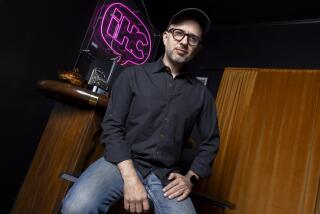1st New Year’s Blast Was Late
- Share via
Los Angeles’ first civic-sponsored New Year’s Eve in 1919 -- an all-night party to celebrate the new electric streetlights along Broadway -- was ushered in no sooner than Jan. 17, 1920. Turns out the elaborate lights couldn’t be turned on by Dec. 31 because city workers were behind schedule.
Yet the much-delayed, all-day-all-night carnival inspired more than 30 more years of big New Year’s Eve parties along a stretch of downtown’s Broadway, a tradition that died in the 1950s when L.A. had spawned suburbs and Broadway had lost its luster as a prime entertainment and shopping district.
But at that better-late-than-never inauguration of streetlights, thousands partied along Broadway like it was New Year’s Eve. Mayor Meredith Pinxton Snyder flipped a switch that illuminated 134 double-globed lights, christening Broadway “The Radiant Way” to compete with New York’s “Great White Way.” Marching bands serenaded the crowds and paraded up and down the street.
Charlie Chaplin, Fatty Arbuckle and Gloria Swanson were among the silent-movie stars who wore masks and costumes as part of a contest. Any partygoer who recognized one of the disguised actors received $25, compliments of Sid Grauman, the movie theater impresario who sponsored the event. Later in the evening, the winners got to dance with the stars.
The evening ended with an explosion of fireworks.
Although the 1920 festival was a success, it took nearly three more years before the Broadway Improvement Assn. turned it into an annual event.
In 1923, with Prohibition strictly enforced, Los Angeles needed an event to attract wintering tourists to the Broadway businesses and theater district.
Though the city couldn’t affect Prohibition, it could change its own laws. The “never on Sunday” blue laws banned dancing after midnight Saturday nights and virtually closed down everything but churches on Sunday. These laws -- so named because they were originally printed on blue paper -- diluted the city’s dance-crazed New Year’s Eve parties in 1920, 1921 and 1922.
Broadway merchants persuaded politicians to temporarily extend the midnight dance ban until 2 a.m. Jan. 1, 1923. The following year, city and county lawmakers repealed the restrictive ordinance, thus extending it to cover every Saturday night.
Rain dampened but didn’t drown out the 1923 New Year’s Eve celebration, the first full-scale gala, according to Times news stories.
With the lid off the dance ban, revelers strolled along Broadway carrying umbrellas, whistles and tiny horns while confetti poured from rooftops and corks popped from ginger ale bottles.
Bartenders along Broadway kept busy serving bitters for as much as 35 cents a shot and “near beer” for a dime a glass.
With or without alcohol, thousands of revelers danced the night away to music that poured into the street from local bars and businesses. Broadway and Hill Street between 3rd and 9th streets were closed to traffic.
In 1924, police banned confetti and feather-tipped whistles that unfurled when they were blown -- “ticklers” -- according to Times news stories. Musicians played and passed the hat while a monkey danced to an organ grinder and collected pennies.
On Dec. 31, 1932, with the Depression in full swing and Prohibition in its last year, empty city coffers and drunken rowdyism spoiled the party. Ivan E. Box, 28, died from a head injury in a fistfight, and Norman Hoyt, 26, was shot through an ankle. It appears the event was either canceled or died down in 1933 and 1934, but by 1935, Broadway was a happening place again.
In some years during World War II, Los Angeles rocked as about 150,000 people cheered and danced along six city blocks of Broadway.
Fancy city restaurants and hotel ballrooms were packed, but they cost too much for the average Angeleno. The fare at the Cocoanut Grove was $16 per person, and the price tag at the Biltmore Bowl rang up at nearly $22 per couple, with champagne and an orchid tossed in.
At the Earl Carroll Theatre on Sunset Boulevard, guests paid $7.50 to eat, dance and see the show, and fan dancer Sally Rand strutted at Florentine Gardens in Hollywood for a price ranging from $4 to $10 per guest, according to Times news stories. By far, Broadway was the best deal in town.
On New Year’s Eve 1940, rooters for the two Rose Bowl teams -- Stanford and Nebraska -- marched the length of Broadway while waving team banners. Nebraska fans turned the lobby of the Rosslyn Hotel at 5th and Main streets into a pep rally. At the game the next day, Stanford beat Nebraska, 21-13.
The last New Year’s Eve Broadway bash -- Dec. 31, 1951 -- was recorded in The Times. It was an event in which “huge throngs” danced along Broadway.
Since then, public gatherings on New Year’s Eve have never caught on as mega-events. The biggest duds were poorly attended millennium events to celebrate the year 2000.
So few people came to rain-soaked outdoor celebrations that then-Mayor Richard Riordan quipped that his citizens were “a bunch of sissies.”
And just last week, rain showers apparently extinguished the Giant Village 2006 concert in a six-block area of downtown.
More to Read
The biggest entertainment stories
Get our big stories about Hollywood, film, television, music, arts, culture and more right in your inbox as soon as they publish.
You may occasionally receive promotional content from the Los Angeles Times.










